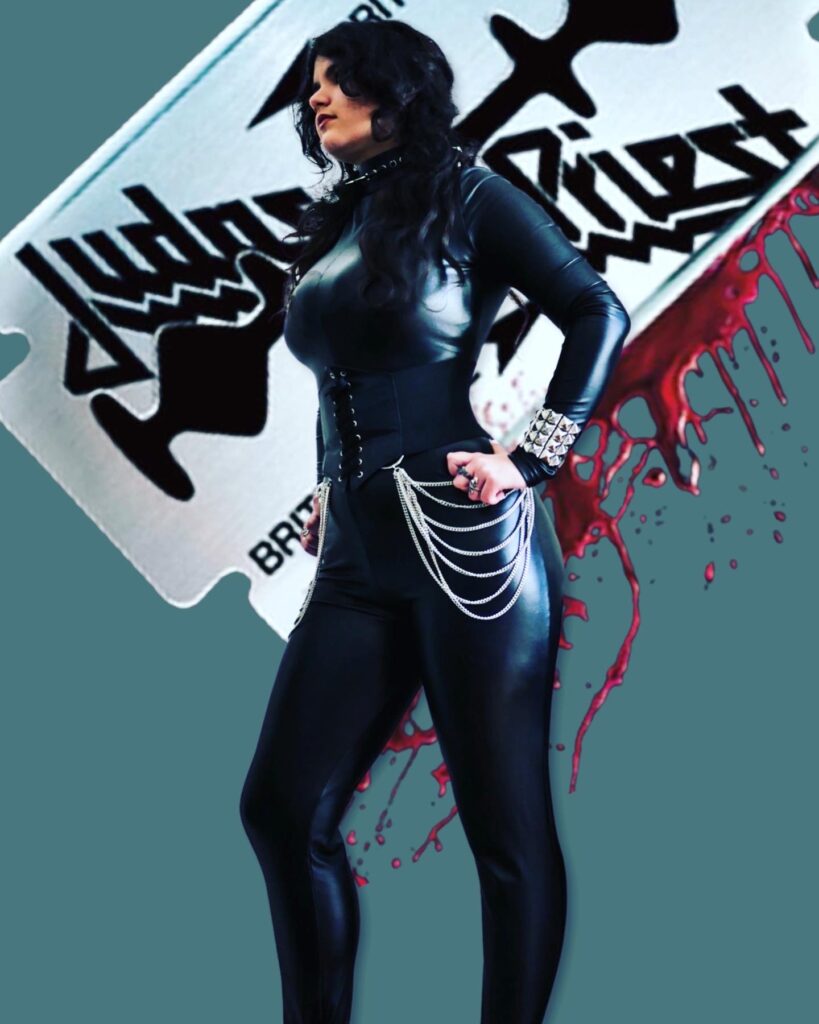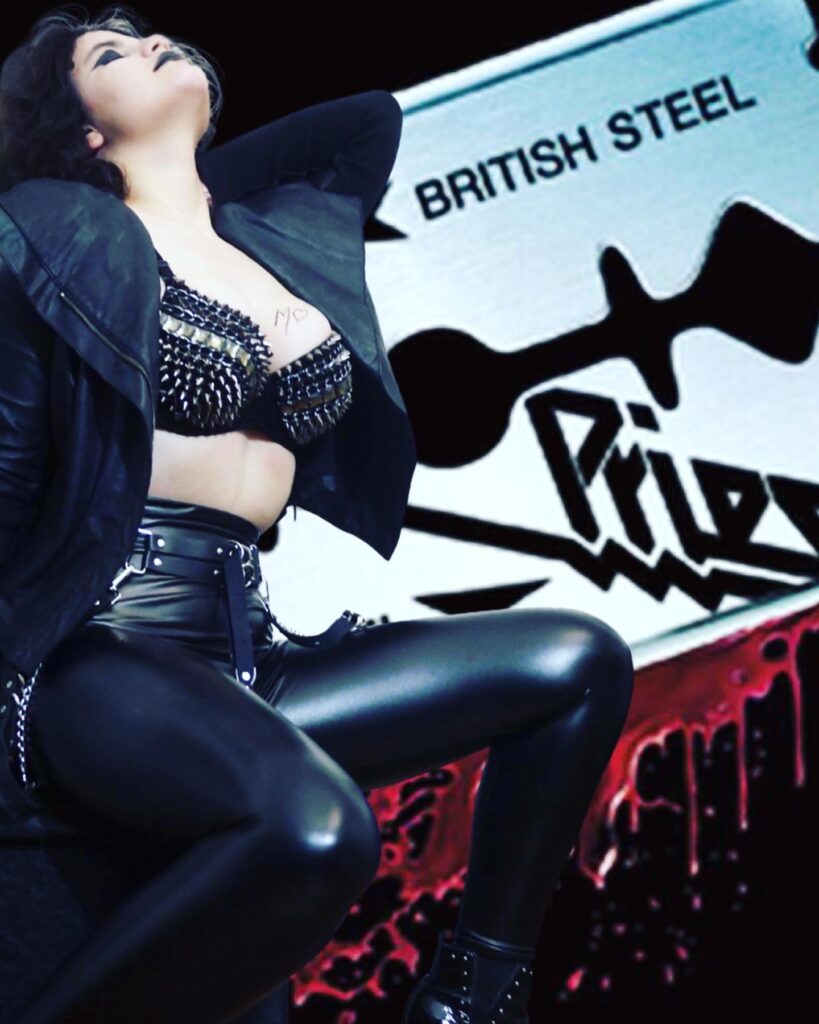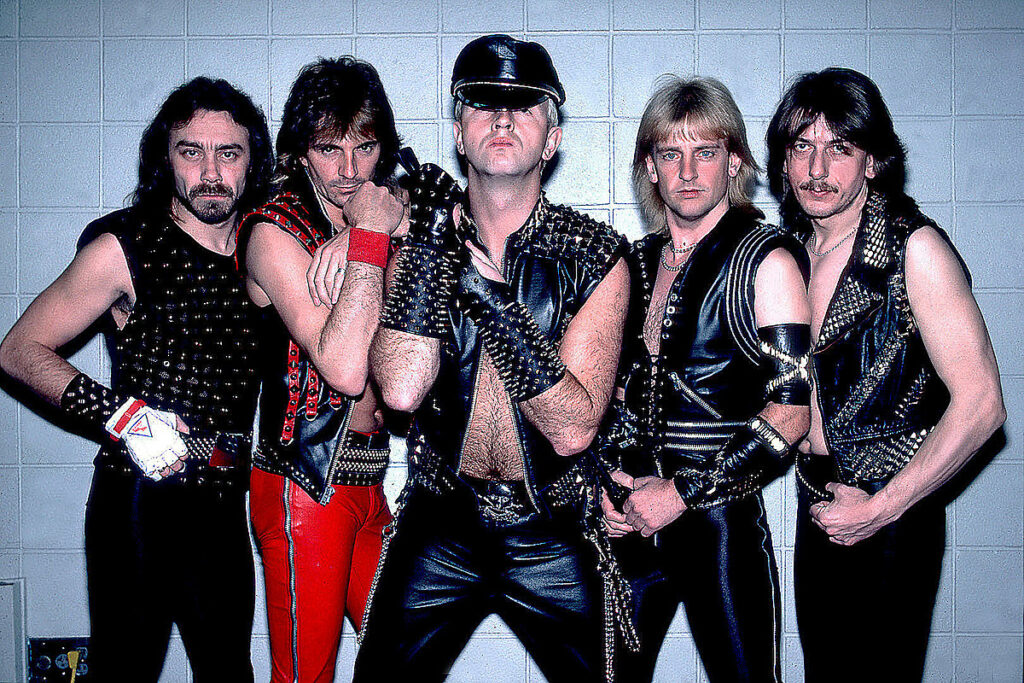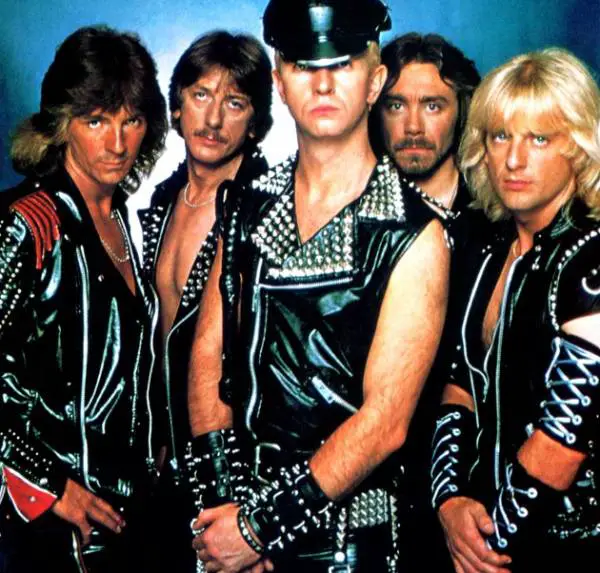Judas Priest

Where does one get started about one of the most influential metal bands of all time? A band who not only inspired countless musicians and metalheads all over the world with the duelling guitar assault from Tipton and Downing, the primal screams of The Metal God, Hill with one of the most solid and
often underrated low ends in the genre, and the solid drumming attack from Scott Travis and his predecessors.
Priest is one of those bands with several eras, finding diehard supporters within all of them. Rocka Rolla, their first album (1974), was basically a blues record with some heavier elements found throughout. As Rocka Rolla was written mostly without Tipton in the mix (as he joined right before
recording), and used some things from the pre-Halford singer, Al Atkins, It kind of stands alone from other
then the basic formulation that would start to come together over the next few records.
By “Sad Wings of Destiny”, their sophomoric effort (1976), the writing trio of Halford, Tipton, and Downing was solidly in place. Considered by many (this writer included) to be one of their strongest albums, it
blows the doors off 1976 with songs such as “The Ripper and Victim of Changes” (live staples to this day, 45 years later), and others, which truly start to set them apart from the pack of what was formulating
into the moniker of Heavy Metal.
Enter 1977, and “Sin After Sin” was thrust upon a waiting fanbase that had started to amass a love for all
things Priest. This one is another favourite of mine, as three of the greatest songs they ever did (in my
opinion) show up here. “Let Us Pray/Call For The Priest, Here Come The Tears and Dissident Aggressor”.
(Slayer must have agreed about Dissident Aggressor, having covered it years later on South of Heaven).
Stained Class came out in early 1978 and would become a very important album for the band for several
reasons. Having several live favourites found throughout the tracklisting, the band also found their cover
of Better By You, Better Than Me, by Spooky Tooth on here, which led to a very arduous lawsuit over a
decade later, which many believe is the reason that the band went on hiatus for a bit. Said hiatus
eventually led to the departure of Halford completely. This subject is way too long to get into here, but
just shows the frivolousness of the US legal system and how free speech came under attack, especially in
music, by the likes of the PMRC (thank you Zappa, Denver, and Snyder for your service), and others who
had a problem with the lyrics of many rock, metal, and hip hop/rap artists.

Just 8 months later(!), Killing Machine came out in October (everywhere but the US). If you’re in the US,
you might recognize this album as Hell Bent For Leather, which came out in March of 1979 to not
compete too much with Stained Class. The band consistently refers to the album as Killing Machine to
this day, and it was only called Hell Bent For Leather here because of the connotation of a “killing
machine” that the label in the US was not a fan of due to the violence of the late 1970s in many
metropolitan areas, etc. The other difference between KM and HBFL is that HBFL had their cover of the
deep Fleetwood Mac cut, The Green Manalishi.
1980 came, and Priest decided it was time to throw down the gauntlet and challenge all
comers to the title of Heavy Metal Gods. British Steel came out and is considered by many to be their
finest moment. Regardless of your opinion on the ranking of this album in the pantheon of their career,
it cannot be argued by anyone that this album was full of songs that made their way in and out of the
setlist for years and some that never left, haha. This is also the first album to feature Dave Holland (RIP)
on drums, with the previous releases being an ever-revolving door of people on the kit. Dave would stay
there for most of the next decade.
1981 happened, and inexplicably, Priest completely changed course and went on more of a commercial
outing with Point of Entry. That’s not to say it’s a BAD album, as it isn’t, but it’s… different. Certainly
not my favorite of the discography and would in fact find itself closer to the bottom of the list. That
said, “Desert Plains” and “Heading Out To The Highway” are two standouts on the album.
I guess whatever they had to get out of their system with PoE passed rather quickly because in 1982,
Screaming for Vengeance came out, and it showed the band doing just that. Aside from the iconic razor
blade on the cover of British Steel, the Hellion bird from the cover is among the most recognizable Priest-related imagery in the band’s history. This album is chock full of hit after hit after hit among the
Priest fanbase, with there not being a bad song on it. It would be easier to list the songs on this album
that don’t make my list of favourites than the plethora of those that do.
After taking two years to extensively tour and recharge their batteries a bit in the writing process, 1984
brought another nearly perfect album with Defenders of the Faith. Like with the Hellion from
Screaming, the Metallian on the cover of Defenders is another iconic piece of Priest imagery. As good as
Screaming is, this writer is even more entranced by the tracklisting on Defenders, with song after song
being a perfectly painted picture of what pure heavy metal was (and should have been!) at the time.

Turbo came in 1986 and is a mixture of the previous three albums, although I consider it a better
but being a bit older and a bit more mature, I guess, I finally decided it’s not nearly as bad as I made it
out to be in my late teens and early 20s. I’ll say it here, too: Turbo Lover is a great song. Sue me.
Reckless is also a GREAT song, and Priest REALLY screwed up when they turned down that song being
included on the Top Gun soundtrack, as no one had any idea how big that movie was going to be when it
hit.
With that mistake, they tried to make up for it in 1988 with Ram It Down, with their cover of Chuck
Berry classic, Johnny B. Goode. That was to be included on the soundtrack of the movie with the same
name (Johnny Be Good). Thankfully for the band, that movie went on to be the biggest movie of all
time, grossing more than the Star Wars Trilogy, Avengers Saga, and Titanic put together, launching the
band into billionaire superstardom with the royalty checks. Obviously, I jest here, but one wonders
what could have happened if they hadn’t turned down Top Gun. This album also saw the departure of
Dave Holland, and according to KK, most of the album was done with a drum machine.

1990 brought the yin and yang of ups and downs for the band, not necessarily financially, but in
hindsight. “Painkiller” came out as my favourite Priest album (MANY fans agree with me on this), and it’s one of my favourite albums from any band ever. “Painkiller” is a perfect record. Nothing more can be said about it without doing it a disservice. This album also saw the changing of the
During this tour, on a date in Canada, Rob had an accident on state on the bike and broke his nose.
Thankfully, he had the guys backstage plaster him up where he could finish the show (causing “Hell Bent For Leather” to be played as an instrumental for the first time in history), but that was the straw
that broke the camel’s back. That, and the trial that I mentioned above, had started to put a strain
on the band, and Halford in particular. He wanted to step back and take a break, but unfortunately, the
band saw things differently (I mostly blame management) and accepted a resignation that he never
gave. 1992 saw what many thought might be the end of Priest.
The band went on a hiatus at this point for quite a few years, not releasing the follow-up to Painkiller
until 1997 with the supremely underrated Jugulator. Jugulator saw the first time that Halford had not
been in the band since 1973. Tim “Ripper” Owens, formerly of a Priest cover band called British Steel, as
well Winters Bane (Heart of a Killer is a CLASSIC album), and the very little-known Brainicide (I been
looking for their demo tapes for years. If you have them, I’m a buyer). Jugulator saw Priest’s heaviest
endeavour to date, with the guitars being turned down and Ripper using more of a guttural tone
throughout the record while keeping the signature stratospheric screams of the band alive as
well. I unapologetically LOVE Jugulator. It’s among my favourite Priest albums. I would do extremely bad
things to see Halford do Cathedral Spires live.
2001 saw the release of Demolition, the second and last album to feature Owens on vocals. While very
much in the same vein as Jugulator, it did slow things down a bit at times and go more of a melodic
route. It is also a very solid album, albeit not quite as in-your-face and pummeling as its predecessor.
Unfortunately for Ripper, the two albums weren’t the thunderous return to form for the band with live
dates, as the band vastly downsized the places they were playing from arenas down to theatres and
clubs. I do not in any way blame Ripper for this, as it was the late 90s and early 2000s. Metal wasn’t
the stalwart it once was. That said, one faithful day, most of the guys met up at a wedding that they
were attending and started talking about what could happen. This brought Rob back into the fold in
2003, and talks for a new album began.
In early 2005, we got that new album. Angel of Retribution came out with uproarious fanfare. It’s
nowhere near a perfect album, but The Metal God was back home where he belonged (he wasn’t
resting on his laurels, having done Fight, Two, and Halford while he was gone) and they put out a very
It is a solid album to show the world that they could still take the world on by force and show them that metal
was still king!
In 2008, Priest did something they weren’t known for doing. They released a full two-disc concept record
on the life and predictions of Nostradamus. It was a very bold undertaking, which had the fanbase quite
split on the merits and execution of such an endeavour. Personally, I love the record, but there is some
filler on there that, if removed, wouldn’t have hurt the record at all in regard to the storytelling and
would have made it more concise and flow better.
Unfortunately, KK left the band not too long after this record and tour happened, and with the amount
of drama that happened around his exit, this is not the place to hash it all out. That would take an
article in itself to even partially cover appropriately. This marks the first time that KK has not been in the
band and leaves Ian Hill as the last original member of the band. Replacing him was Richie Faulkner,
who played guitar for Lauren Harris on the tour when she opened for Maiden (it helps when your dad is
the one calling the shots �� ). Another bit of trivia: he’s also the son-in-law of George Lynch (Dokken,
Lynch Mob).
The band took their time in recording a follow-up to Nostradamus, not releasing Redeemer of Souls until
- It took them some time to get their bearings, with KK being out of the band and one-third of the
main songwriting trio being gone from the process. I feel this album is a bit underrated and doesn’t
deserve the 62% that it currently sits at on Metal Archives. It’s a better album than that. Halls of
Valhalla is an absolute headbanger.
Their final album as of this writing, released in 2018, Firepower, is most likely their best record since
Jugulator. It’s a phenomenal record which saw Andy Sneap at the production helm, and we all owe him
a debt of gratitude that we can never repay for his work with Priest, Accept, Nevermore, and many
others. Not to mention his pivotal role in getting Hell back together and his work in Sabbat many years
prior. This newly found working relationship also saw Andy on stage with the band, filling in for the ailing
Glenn Tipton suffers from Parkinson’s and is unable to play at the same level he once did most of
the time. He still writes with the band, records when able, and joins the band on tour for certain songs
at certain shows.
It was announced in 2022 that Judas Priest was finally being inducted into the most benign and ill–
thought about the Rock & Roll Hall of Fame. Unfortunately, at almost an insult at this point, they are being
inducted and receiving the Musical Excellence Award, which many see as just a consolation prize and
not a true induction. The positive to this, though, is the fact KK Downing will be in attendance and being
inducted with them. Maybe this will allow for some talk amongst them that would just be old mates
chatting, vs going through lawyers and management. It’s how Halford came back into the fold in 03.
Personally, I’d love to see Priest with both Richie and KK sharing the stage together, as it should have
been when Glenn had to mostly step away.
This article feels extremely brief for a band that has literally been around for 50(!) years, but without
writing a book or seven on the subject, one can’t adequately put on paper the impact that Priest has had
on heavy metal, pop culture, and music as a whole. So much was not covered here at all or just briefly
glossed over. Unfortunately, one in this position has no choice but to do so. I hope that you’ll forgive
me and crank the fuck up out of Painkiller while you destroy your living room.
Horns up!
Brent Erwin @HellBrentForLeather

In addition, they are considered to be the forerunners of Metal looks on outfits and clothing, the main one responsible for which was vocalist Rob Halford. This new dress based on leather and metallic props, taken from masochism and sexual fetishism, was first seen on the cover of the single “Better By You, Better Than Me” (January 1978) and was highly popularized during the release of “Hell Bent for Leather.” This new way of dressing received great attention in later Metal, from the New Wave of British Heavy Metal through extreme Metal to 1980s Glam Metal.
As for their music, their early albums are cited as direct influences for metal and its later subgenres. In the review of Sad Wings of Destiny, for example, Steve Huey of “Allmusic” mentioned, “It took heavy metal to new depths of darkness and to new levels of technical precision. Similarly, Stained Class is held as a reference for thrash metal, speed metal, and even NWOBHM. Some individual songs were equally important for the development of metal in general. One example is “Genocide” from 1976, which, according to writer Mikal Gilmore, is one of the roots of thrash and a major inspiration for the extreme metal bands of the 1980s. Call for the Priest” and “Dissident Aggressor” from 1977 are also cited as the first steps of speed and thrash, respectively.
On the other hand, and similar to Motörhead, there is some discrepancy as to whether or not they are part of the New Wave of British heavy metal. However, several critics claim that they were one of the movement’s forerunners, including pioneering groups of the same, such as Saxon and Venom, to name a few who have already named them with one of their main influences. Similarly, the Germans of Accept consider Priest essential to their career. Their legacy also played a key role in the future thrash metal and groove metal of bands like Overkill, Slayer, Metallica, Megadeth, Anthrax, Annihilator, Kreator and Pantera. The power metal of Halloween, Gamma Ray and Primal Fear was partly inspired by the British quintet. The same thing happened with dozens of groups from other subgenres such as glam, black and death and had a direct influence on the sound of Twisted Sister, Lizzy Borden, Skid Row, Death, Mercyful Fate, King Diamond, Queensrÿche, Opeth and Gorgoroth, among others.
Finally, Judas Priest has received dozens of awards and honours over the years, both for their albums and the ensemble. Highlights include their inclusion in Kerrang! Magazine’s Hall of Fame in 2007, the Revolver Golden Gods Awards in 2010, and the Golden Gods Icon, both given by Metal Hammer magazine. In 2006, along with Queen, Kiss, and Def Leppard, they were the first artists to be inducted into the VH1 Rock Honors, a ceremony that honours bands that have been influential in rock music.
Rocka Rolla
Released: 6 September 1974
1976 Sad Wings of Destiny
Released: 26 March 1976
1977 Sin After Sin
Released: 8 April 1977
1978 Stained Class
Released: 10 February 1978
Killing Machine (released in the US as Hell Bent for Leather in 1979)
Released: 9 October 1978
1980 British Steel
Released: 11 April 1980
1981 Point of Entry
Released: 27 February 1981
1982 Screaming for Vengeance
Released: July 1982
1984 Defenders of the Faith
Released: 13 January 1984
1986 Turbo
Released: 21 March 1986
1988 Ram It Down
Released: 13 May 1988
1990 Painkiller
Released: 14 September 1990
1997 Jugulator
Released: 28 October 1997
2001 Demolition
Released: 31 July 2001
2005 Angel of Retribution
Released: 28 February 2005
2008 Nostradamus
Released: 17 June 2008
2014 Redeemer of Souls
Released: 15 July 2014
2018 Firepower
Released: 9 March 2018
